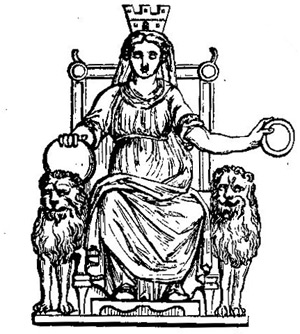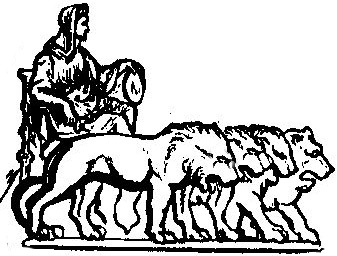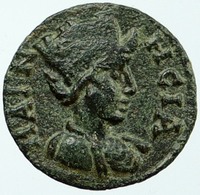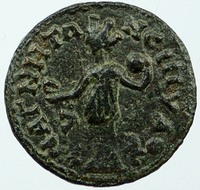Greek city of Magnesia ad Sipylum in Lydia
Pseudo-Autonomous Issue
Bronze 17mm (3.12 grams) Struck circa 200-300 A.D.
Reference; SNG Copenhagen 254; SNG München 239; BMC 39.
MAΓNHCIA, Turreted and draped bust of Tyche right.
MAΓNHTΩN CIΠVΛO, Cybele standing left, holding patera and tympanum; lion to left and right. You are bidding on the exact item pictured, provided with a Certificate of Authenticity and Lifetime Guarantee of Authenticity.
 Rhea (known by Romans as Cybele), an ancient Greek goddess, appears to have been a goddess of the earth. She is represented as a daughter of Uranus and Ge, and the wife of Cronos, by whom she became the mother of Hestia, Demeter, Hera, Hades, Poseidon and Zeus. Cronos devoured all his children by Rhea, hut when she was on the point of giving birth to Zeus, she went to Lyctus in Crete, by the advice of her parents. When Zeus was born she gave to Cronos a stone wrapped up like an infant, which the god swallowed supposing it to be his child. Crete was undoubtedly the earliest seat of the worship of Rhea; though many other parts of Greece laid claim to the honor of being the birth-place of Zeus. Rhea was afterwards identified by the Greeks in Asia Minor with the Great Asiatic goddess, known under the name of " the Great Mother,"' or the " Mother of the Gods," and also bearing other names such as Cybele, Agdistis, Dindymene. Hence her worship became of a wild and enthusiastic character, and various Eastern rites were added to it, which soon spread throughout the whole of Greece. From the orgiastic nature of these rites, her worship became closely connected with that of Dionysus (Dionysos). Under the name of Cybele her worship was universal in Phrygia. Under the name of Agdistia, she was worshipped with great solemnity at Pessinus in Galatia, which town was regarded as the principal seat of her worship. Under different names we might trace the worship of Rhea even much further east, as far as the Euphrates and even Bactriana. She was, in fact, the great goddess of the Eastern world, and we find her worshipped there under a variety of forms and names. As regards the Romans, they had from the earliest times worshipped Jupiter and his mother Ops, the wife of Saturn. During the war with Hannibal (2nd Punic War) the Romans fetched the image of the Mother of the Gods from Pessinus ; but the worship then introduced was quite new to them, and either maintained itself as distinct from the worship of Ops, or became united with it. A temple was built to her on the Palatine, and the Roman matrons honored her with the festival of the Megalesia. In all European countries Rhea was conceived to be Rhea (known by Romans as Cybele), an ancient Greek goddess, appears to have been a goddess of the earth. She is represented as a daughter of Uranus and Ge, and the wife of Cronos, by whom she became the mother of Hestia, Demeter, Hera, Hades, Poseidon and Zeus. Cronos devoured all his children by Rhea, hut when she was on the point of giving birth to Zeus, she went to Lyctus in Crete, by the advice of her parents. When Zeus was born she gave to Cronos a stone wrapped up like an infant, which the god swallowed supposing it to be his child. Crete was undoubtedly the earliest seat of the worship of Rhea; though many other parts of Greece laid claim to the honor of being the birth-place of Zeus. Rhea was afterwards identified by the Greeks in Asia Minor with the Great Asiatic goddess, known under the name of " the Great Mother,"' or the " Mother of the Gods," and also bearing other names such as Cybele, Agdistis, Dindymene. Hence her worship became of a wild and enthusiastic character, and various Eastern rites were added to it, which soon spread throughout the whole of Greece. From the orgiastic nature of these rites, her worship became closely connected with that of Dionysus (Dionysos). Under the name of Cybele her worship was universal in Phrygia. Under the name of Agdistia, she was worshipped with great solemnity at Pessinus in Galatia, which town was regarded as the principal seat of her worship. Under different names we might trace the worship of Rhea even much further east, as far as the Euphrates and even Bactriana. She was, in fact, the great goddess of the Eastern world, and we find her worshipped there under a variety of forms and names. As regards the Romans, they had from the earliest times worshipped Jupiter and his mother Ops, the wife of Saturn. During the war with Hannibal (2nd Punic War) the Romans fetched the image of the Mother of the Gods from Pessinus ; but the worship then introduced was quite new to them, and either maintained itself as distinct from the worship of Ops, or became united with it. A temple was built to her on the Palatine, and the Roman matrons honored her with the festival of the Megalesia. In all European countries Rhea was conceived to be accompanied by the Curetes, who are inseparably connected with the birth and bringing up of Zeus in Crete, and in Phrygia by the Corybantes, Atys, and Agdistis. The Corybantes were her enthusiastic priests, who with drums, cymbals, horns, and in full armor, performed their orgiastic dances in the forests and on the mountains of Phrygia. In Rome the Galli were her priests. The lion was sacred to her. In works of art she is usually represented seated on a throne, adorned with the mural crown, from which a veil hangs down. Lions appear crouching on the right and left of her throne, and sometimes she is seen riding in a chariot drawn by lions. accompanied by the Curetes, who are inseparably connected with the birth and bringing up of Zeus in Crete, and in Phrygia by the Corybantes, Atys, and Agdistis. The Corybantes were her enthusiastic priests, who with drums, cymbals, horns, and in full armor, performed their orgiastic dances in the forests and on the mountains of Phrygia. In Rome the Galli were her priests. The lion was sacred to her. In works of art she is usually represented seated on a throne, adorned with the mural crown, from which a veil hangs down. Lions appear crouching on the right and left of her throne, and sometimes she is seen riding in a chariot drawn by lions.
Magnesia ad Sipylum (Greek: Mαγνησία του Σιπύλου) (modern Manisa, Turkey), was a city of Lydia, situated about 65 km northeast of Smyrna (now İzmir) on the river Hermus (now Gediz) at the foot of Mount Sipylus. The city should not be confused with its older neighbor, Magnesia on the Maeander, both founded by colonists from the Greek region of Magnesia. The first famous mention of the city is in 190 BC, when Antiochus the Great was defeated in the battle of Magnesia by the Roman consul Lucius Cornelius Scipio Asiaticus. It became a city of importance under Roman rule and, though nearly destroyed by an earthquake in the reign of Tiberius, was restored by that emperor and flourished through the Roman empire. It was an important regional centre through the Byzantine Empire, and during the 13th century interregnum of the Empire of Nicea. Magnesia housed the Imperial mint, the Imperial treasury, and served as the functional capital of the empire until the recovery of Constantinople in 1261. Magnesia was one of the few towns in this part of Anatolia which remained prosperous under the Turkish rule. Landmarks Early 20th century postcard image of the Hittite statue of the Mother Goddess Kybele in Mount Sipylus Early 20th century postcard image of the Hittite statue of the Mother Goddess Kybele in Mount Sipylus There are two famous relics of antiquity. The first is the Niobe of Sipylus (Aglayan Kaya), a natural rock formation, on the lowest slopes of the mountains in the middle of town. The second is a carving, allegedly of Cybele (Suratlu Tash) about 100 meters up the mountain about 6 km east of the town. This is a colossal seated image cut in a niche of the rock, of Hittite origin, and perhaps that called by Pausanias the very ancient statue of the Mother of the Gods, carved by Broteas, son of Tantalus, and sung by Homer. It can be seen by driving into a parking lot at a children's playground. Near the carving lie many remains of a primitive city, and about a kilometer east is the rock-seat conjecturally identified with Pausanias's Throne of Pelops. There are also hot springs and a sacred grotto of Apollo. Parts of the major fortifications built during the Empire of Nicea remain evident. MagnetismOne of the regions colonized by the Magnetes was a primary source for mysterious stones that could attract or repel each other, possibly leading to the modern term for magnets and magnetism. Some suggest that it was Magnesia ad Sipylum, others that it was the Magnesia regional unit in Thessaly; this has been debated both in modern times and in antiquity without resolution.
 Lydia was an Iron Age kingdom of western Asia Minor located generally east of ancient Ionia in the modern western Turkish provinces of Uşak, Manisa and inland İzmir. Its population spoke an Anatolian language known as Lydian. Lydia was an Iron Age kingdom of western Asia Minor located generally east of ancient Ionia in the modern western Turkish provinces of Uşak, Manisa and inland İzmir. Its population spoke an Anatolian language known as Lydian.
At its greatest extent, the Kingdom of Lydia covered all of western Anatolia. Lydia (known as Sparda by the Achaemenids) was a satrapy (province) of the Achaemenid Persian Empire, with Sardis as its capital. Tabalus, appointed by Cyrus the Great, was the first satrap (governor). (See: Lydia (satrapy).) Lydia was later the name of a Roman province. Coins are said to have been invented in Lydia around the 7th century BC.
|


 Rhea (known by Romans as
Rhea (known by Romans as  accompanied by the Curetes, who are inseparably connected with the birth and bringing up of
accompanied by the Curetes, who are inseparably connected with the birth and bringing up of  Early 20th century postcard image of the Hittite statue of the Mother Goddess Kybele in Mount Sipylus
Early 20th century postcard image of the Hittite statue of the Mother Goddess Kybele in Mount Sipylus  Lydia was an Iron Age kingdom of western Asia Minor located generally east of ancient Ionia in the modern western Turkish provinces of Uşak, Manisa and inland İzmir. Its population spoke an Anatolian language known as Lydian.
Lydia was an Iron Age kingdom of western Asia Minor located generally east of ancient Ionia in the modern western Turkish provinces of Uşak, Manisa and inland İzmir. Its population spoke an Anatolian language known as Lydian.
